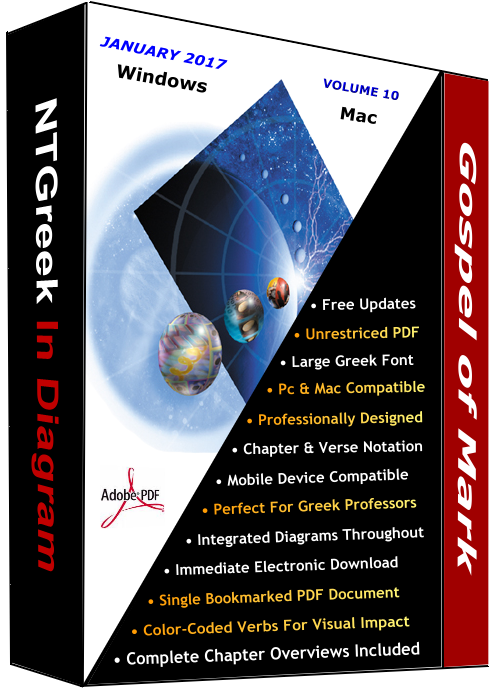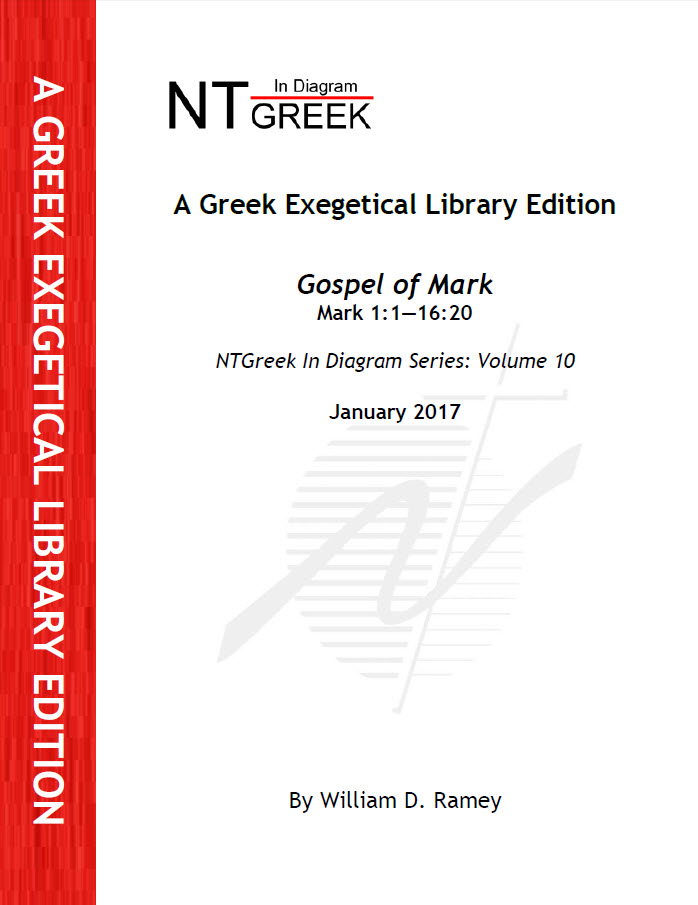

Title:
Gospel of Mark (1:1--16:20)Series:
NTGreek In Diagram: Volume 10Edition:
January 2017Last Update:
October 6, 2016ISBN-10:
1939762002ISBN-13:
978-1-939762-02-3Language:
Greek diagrams with English commentsFormat:
Electronic downloadable PDF bookmarked documentLength:
595 pages (including overviews and "printer-friendly" pages)Price:
$8.95 USDThe Gospel is one of the three Synoptic Gospels and narrates the ministry of Jesus from His baptism by John the Baptist to His death and resurrection. Mark does not leave any doubt as to whom Jesus is. In his first sentence of his Gospel he writes that Jesus is the "Christ, the Son of God." Jesus' first recorded words are "The time is fulfilled, and the Kingdom of God is at hand; repent and believe in the Gospel" (Mark 1:15; cf. 1:11; 3:11; 5:7; 9:7; 13:32; 14:36, 61-62).
The words and works of Jesus are revealed with vivid detail as depicted by the one hundred and fifty-one historical presents. The historical presents presents the narrative as if it is happening, not simply what happened. Mark engulfs his readers into the scenes where they may visualize and feel what he is describing. Mark passionately uses minute detail to heighten the sense of being there. He also address his readers more directly by explaining the meaning for them of certain actions and statements.
More than any other gospel, Mark records more miracles of Jesus and with breath-taking speed. He punctuates his picturesque narrative with many adverbs, defining and emphasizing his expressions. For example, he uses the adverb "immediately" to express vividness and excitement to the narrative. The characters in his Gospel are related with unusual candor and vividness, such as Jesus' hearers who are amazed, his disciples who do not understand, and Jesus who has emotions and great compassion. He alone identifies Simon of Cyrene as the father of Alexander and Rufus (Mk. 15:21; cf. Rom. 16:13).
Mark's literary style is simple and his vocabulary choices reveal that he was well acquainted with colloquial Greek, but a comparative stranger to the literary use of the language. His style has a Semitic flavor, corresponding closer to Hebrew and Aramaic syntax than Hellenistic syntax. For example, verbs are frequently located at the beginning of his sentences, as well as an abundant presence of asyndeta (the placing of clauses together without the use of conjunctions) and parataxis (the joining of clauses with the conjunction KAI). His style is less elaborate than Luke or Matthew. He also uses few scriptural quotations or references to underscore fulfilled prophecy.
One thousand three hundred and thirty distinct words embrace the Gospel's record, of which sixty are proper names. Eighty words are not found elsewhere in the Greek New Testament. He makes very frequent use of participles, direct speech, and double negatives. He varies his tenses to bring out different shades of meaning. All of the omitted verses in the UBS 4th Edition Greek Text (7:16; 9:44, 46; 11:26; 15:28; 16:9-20) are also included in this diagram set.

 The Gospel of Mark is also part of the NTGreek In Diagram's
Master Diagram and Master Diagram Upgrade Collections. The Collections include
all diagrams in a single convenient bookmarked PDF document that makes navigation incredibly easy.
The Gospel of Mark is also part of the NTGreek In Diagram's
Master Diagram and Master Diagram Upgrade Collections. The Collections include
all diagrams in a single convenient bookmarked PDF document that makes navigation incredibly easy.
If you are a Greek professor or instructor and desire more information about group discounts, please contact me. Several Greek professors and instructors encourage their students to purchase the diagrams and use them as part of the class curriculum.
The following screen shots are representative pages from the Gospel of Mark. The purchased diagram set includes all the diagrams. Click on any thumbnail to view its larger image.

 Cover Page
Cover Page Title Page
Title Page Mark 1:9-11
Mark 1:9-11 Mark 1:27-28
Mark 1:27-28 Mark 2:14-15
Mark 2:14-15 Mark 3:4-5
Mark 3:4-5 Mark 4:2-4
Mark 4:2-4 Mark 5:5-7
Mark 5:5-7 Mark 6:7-9
Mark 6:7-9 Mark 7:14-17
Mark 7:14-17 Mark 8:17-19b
Mark 8:17-19b Mark 9:12-13
Mark 9:12-13 Mark 10:24b-25
Mark 10:24b-25 Mark 11:1-2c
Mark 11:1-2c Mark 12:18-19
Mark 12:18-19 Mark 13:3-4
Mark 13:3-4 Mark 14:65-67
Mark 14:65-67 Mark 15:16-19
Mark 15:16-19 Mark 15:31-32
Mark 15:31-32 Mark 16:6-7
Mark 16:6-7 Mark 16:9-11
Mark 16:9-11galeria lightboxby VisualLightBox.com v6.1